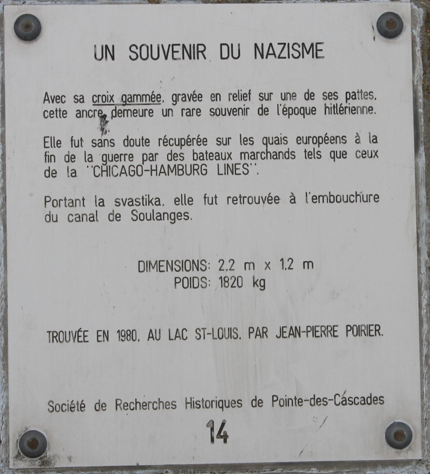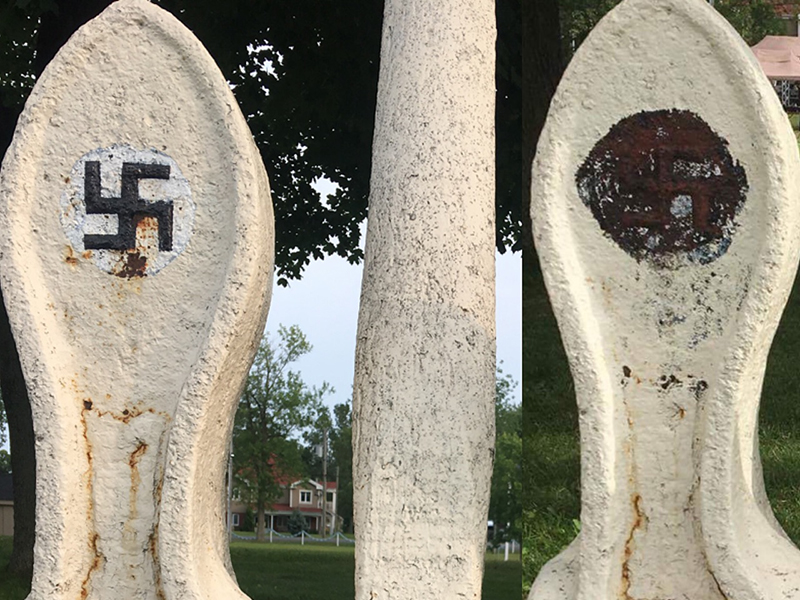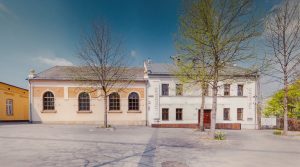A village west of Montreal says it will provide fuller, more accurate information next to an anchor that bears an embossed swastika and is on display in a public park.
Centre for Israel and Jewish Affairs (CIJA) Quebec co-chair Rabbi Reuben Poupko said the organization met with municipal officials in Pointe-des-Cascades, Que., and is satisfied with their response to the controversy that erupted this week over the anchor, which has been at that site for many years.
It’s part of a permanent exhibition of anchors that have been recovered near the town, which is on Lac St. Louis, a major shipping artery at the confluence of the St. Lawrence and Ottawa Rivers.
Rabbi Poupko said it has been determined that the anchor is from a British merchant vessel and predates the Nazi era. Its swastika is vertical, denoting the ancient symbol of good luck or prosperity, rather than rotating to the right, as the Nazis used it.
READ: SLEW OF CRYPTIC, ANTI-SEMITIC GRAFFITI FOUND IN WINNIPEG
CIJA did not ask for the anchor’s removal, or for the swastika to be covered.
“However, given the sensitivities surrounding the swastika and what it represents almost universally today, the town agreed with us that an explanation should be given of its background,” said Rabbi Poupko.
The municipality issued an earlier public statement that it would not remove the anchor because of its significance to local history, having been found by divers more than a quarter-century ago.
Pointe-des-Cascades, a village of 1,300, which is part of the Vaudreuil-Soulages Regional County Municipality, told CIJA that the municipality will install a new plaque describing the anchor’s background and, specifically, why the swastika is an affront, in the aftermath of the Holocaust.

The existing plaque, put up by the local historical society some time ago, says the anchor was recovered from Lac St. Louis in 1988 from “an unknown boat.… The only inscription that we could identify is the swastika on one of its flukes that indicates to us its country of origin.”
Controversy was sparked by Corey Fleischer, who owns a power-washing company and has been removing hate-filled graffiti around Montreal for several years and posting his activities on social media. He recently founded a movement called Erasing Hate that he hopes to take globally and has been stepping up his activism.
On Aug. 19, after being notified by one of his followers of the swastika’s existence in St-Pierre Park, Fleischer headed to the village. Without informing the municipality, he began obliterating the, apparently recent, black-and-white paint surrounding the swastika that’s embossed into the metal of the anchor.
Mayor Gilles Santerre came to the scene and told him to stop. He called in the provincial police after Fleischer refused. The Sûreté du Québec told Fleischer he could be charged with damaging public property – an exchange Fleischer video recorded and posted on his Facebook page.
“The village of Pointe-des-Cascades does not endorse Nazism,” Santerre told the media. “Our village has a beautiful community and family spirit, and creates events that bring people together.”
Fleischer remains adamant that the anchor should be removed, or relegated to a museum, because it is unacceptable to display a swastika in public, regardless of the context. He also points out that the existing plaque says the anchor is “a memory of Nazism” and maintains that by painting it with black lines and a white circle behind it, the municipality has turned it into the symbol adopted by the Third Reich.
In a separate incident on Aug. 23, Fleischer removed the German phrase “Arbeit mach frei” from equipment in a playground in the Montreal neighbourhood of Mile End.
This was the ominous warning above the gates of Auschwitz.
A resident reported the graffiti in Alphonse Telesphore Park to the Plateau Mont-Royal borough on that day. When it had not been removed by the city by 1:15 p.m., Fleischer acted to do so – without incident.







